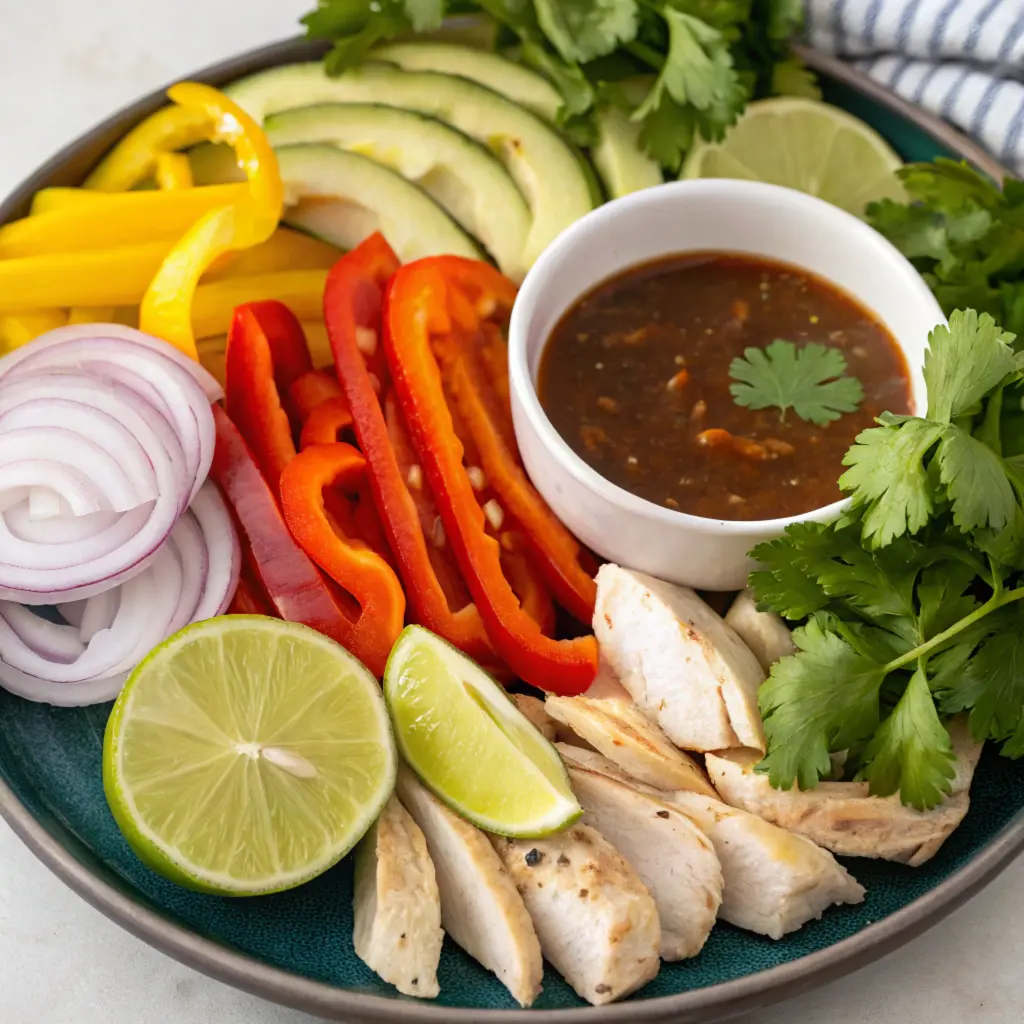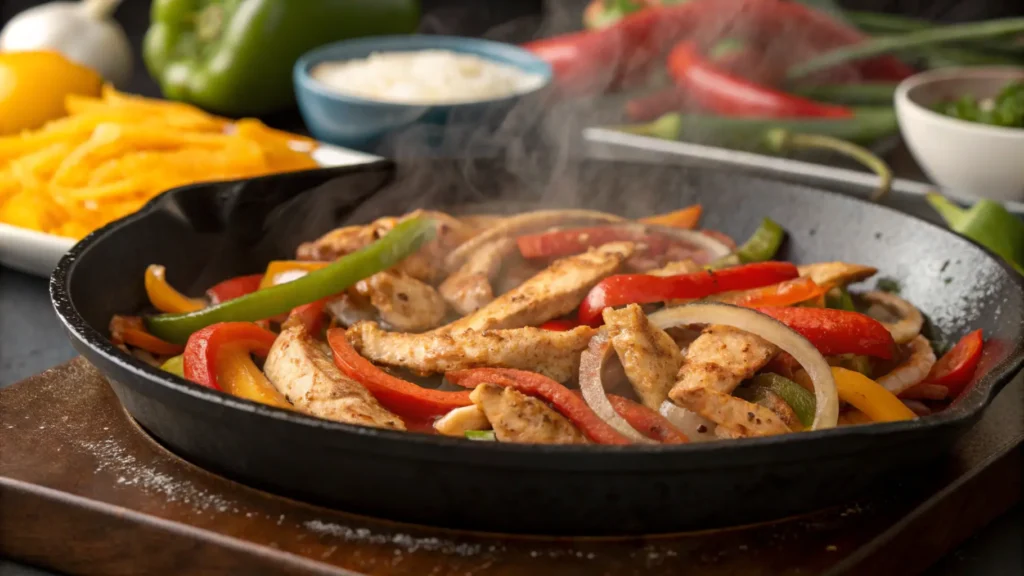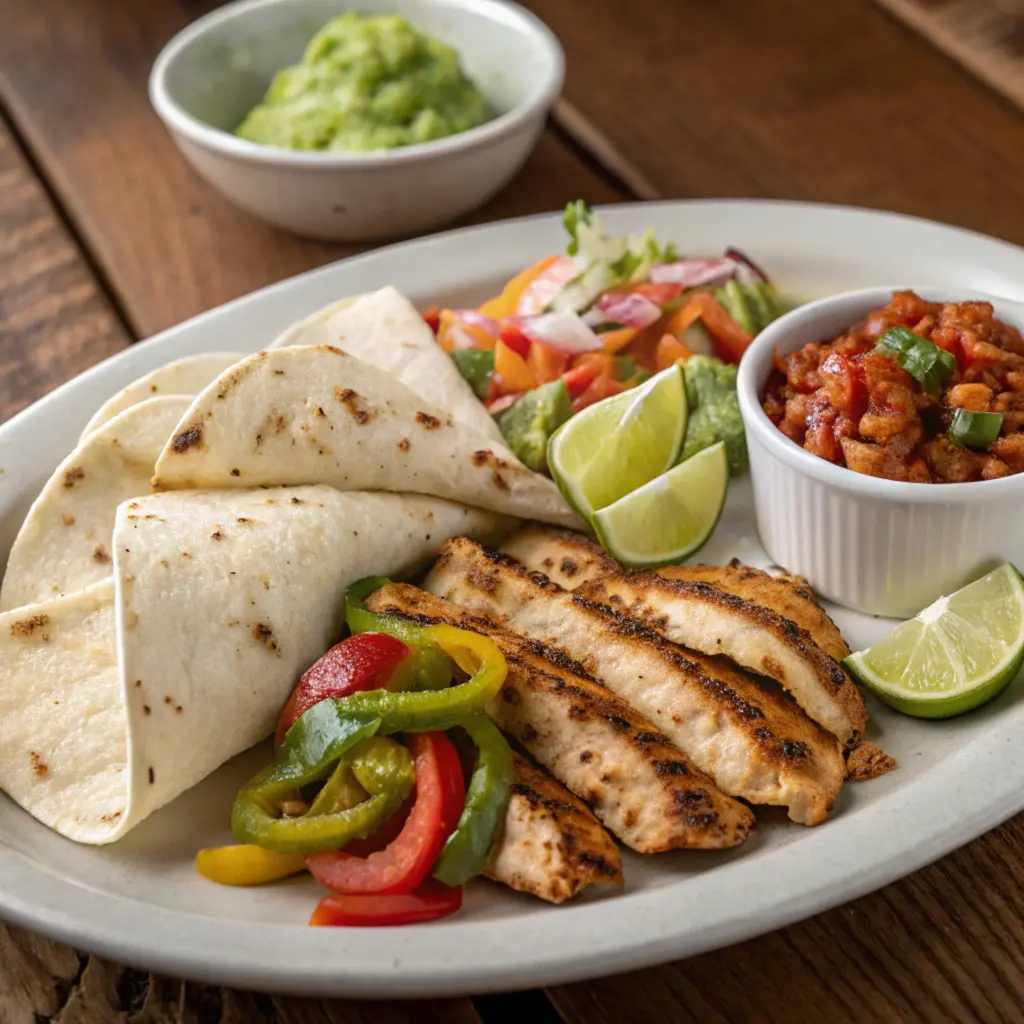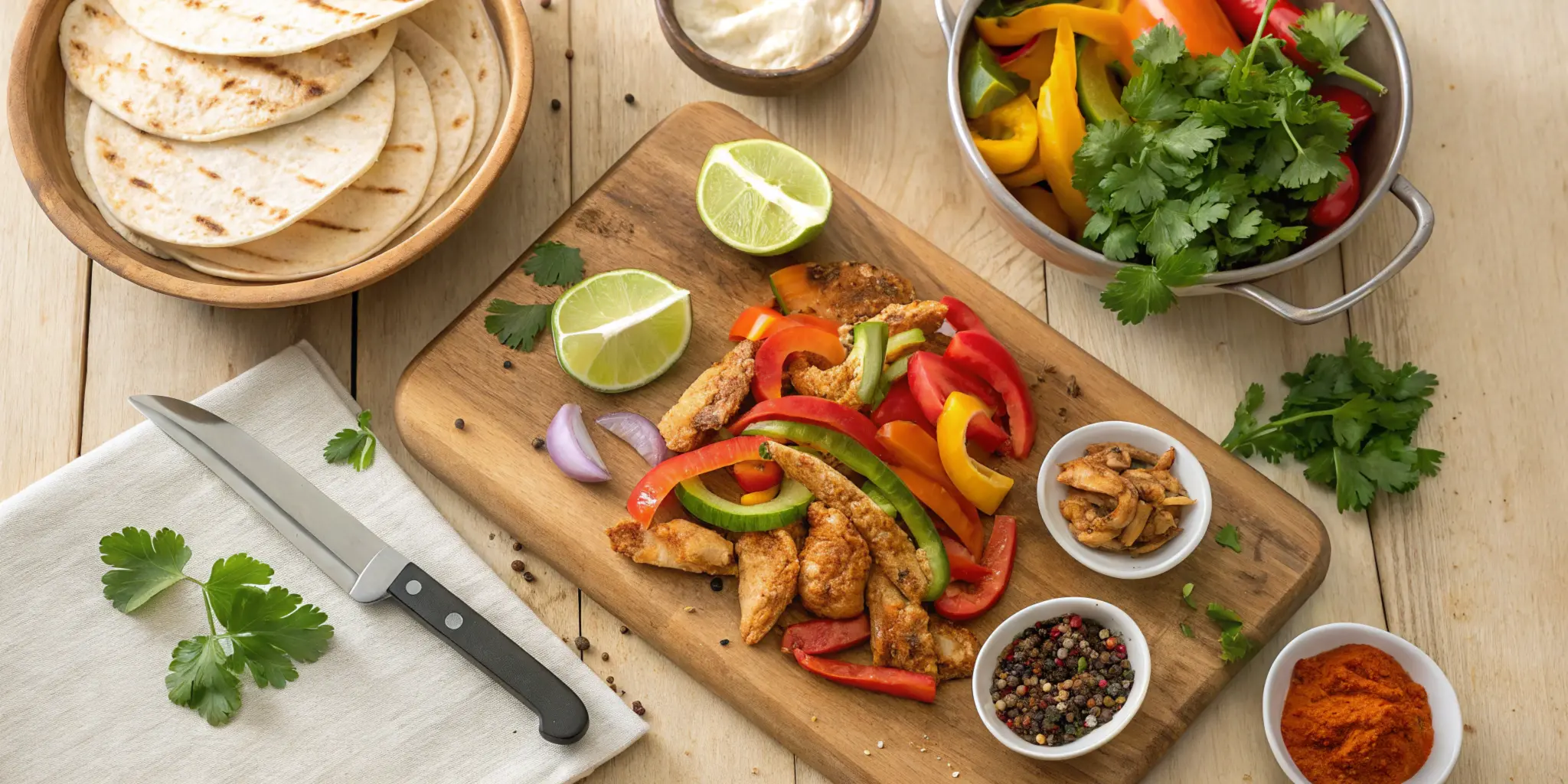Chicken fajitas are a family favorite, and the marinade is where all the magic happens. A good chicken fajita marinade brings together vibrant citrus notes, the warmth of spices, and just the right touch of heat to transform plain chicken into something truly delicious. In this article, you’ll discover everything you need to know to make the perfect marinade, from the ingredients and preparation steps to variations, cooking methods, and serving ideas.
What Is Chicken Fajita Marinade?
Chicken fajita marinade is a flavor-packed mixture used to tenderize and season chicken before cooking. The combination of ingredients not only infuses the meat with vibrant taste but also helps it stay juicy during cooking. Typically, it includes a mix of citrus juice, oils, and spices, which come together to create a marinade that’s as versatile as it is tasty.
Why Is Marinating Important for Chicken Fajitas?
Marinating your chicken is more than just adding flavor—it’s a game-changer when it comes to texture and moisture. The acidity from lime or lemon juice breaks down tough proteins, making the chicken tender and easier to chew. Meanwhile, spices and herbs penetrate the meat for a bold and satisfying flavor in every bite.
A Brief History of Fajitas and Their Marinade
The word “fajita” comes from the Spanish term for “little belts,” referring to the shape of the meat slices. Fajitas originated in Texas-Mexico border towns and were traditionally made using beef, but the method was later adapted for chicken. The marinade is a relatively modern addition, designed to enhance the flavor of lean meats like chicken while preserving their juiciness during high-heat cooking.
If you’re looking for more details on creating a flavorful marinade, check out our Ultimate Guide to Crafting the Perfect Chicken Fajita Marinade for tips and recipes.
Essential Ingredients for Chicken Fajita Marinade
Creating a flavorful chicken fajita marinade begins with the right combination of ingredients. Each element plays a vital role in enhancing the taste and texture of your chicken. From zesty citrus to earthy spices, these ingredients come together in perfect harmony to make every bite unforgettable.
Citrus Elements: Lime and Lemon Juice
Citrus is the heart of any great chicken fajita marinade. Lime and lemon juice bring a bright, tangy flavor that cuts through the richness of the chicken. But they’re not just about taste! The acidity in these juices works to tenderize the meat, breaking down proteins and allowing the marinade to soak in deeply. If you’re short on limes, lemons make an excellent substitute. Want a sweeter twist? Add a splash of orange juice to balance the tartness.
Oils: Olive Oil and Alternatives
Oil acts as the carrier for all the spices and herbs in the marinade. Olive oil is a popular choice because of its mild, fruity flavor, but you can also use alternatives like avocado oil or sunflower oil if you prefer. The oil helps the spices adhere to the chicken and ensures even cooking by preventing it from drying out on the grill or skillet.
Spices and Herbs: Cumin, Chili Powder, Paprika, and More
Here’s where the magic truly happens. The spice blend gives your fajitas their signature kick. Cumin adds warmth, chili powder brings heat, and paprika contributes a smoky depth that ties everything together. You can also toss in garlic powder, onion powder, and oregano for extra layers of flavor. If you love bold flavors, experiment with cayenne pepper or smoked paprika to intensify the taste. Fresh herbs like cilantro can be added for a burst of freshness, but they’re best saved for the end of cooking to preserve their bright color and taste.
Step-by-Step Guide to Making Chicken Fajita Marinade
Creating a mouthwatering chicken fajita marinade doesn’t have to be complicated. With the right techniques and a few simple steps, you can achieve a perfectly seasoned marinade that infuses the chicken with incredible flavor. Let’s break it down so you can get started right away!

Measuring and Mixing Ingredients
Precision is key when it comes to balancing the flavors of a fajita marinade. Here’s how you can prepare it step by step:
- Gather the Ingredients
Start with the essentials: fresh lime juice (about 2–3 limes), olive oil (2 tablespoons), and a blend of spices. You’ll need cumin, chili powder, smoked paprika, garlic powder, onion powder, salt, and pepper. - Combine Liquids First
In a medium-sized mixing bowl, whisk together the lime juice and olive oil. This ensures the base of your marinade is evenly blended. - Add the Spices Gradually
Sprinkle in the spices one by one, starting with the cumin and chili powder for depth and heat. Add paprika for smokiness, then finish with salt and pepper to taste. Whisk thoroughly until the mixture is smooth and aromatic. - Adjust to Taste
Want a bit more heat? Add a pinch of cayenne pepper. Prefer it on the milder side? Reduce the chili powder slightly.
Pro Tip: Use a glass or stainless steel bowl to mix your marinade. Avoid reactive materials like aluminum, as the acidity from the citrus could affect the flavor.
Marinating Techniques: Duration and Methods
Now that your marinade is ready, it’s time to use it effectively to maximize flavor.
- Prepare the Chicken
Slice chicken breasts or thighs into thin strips for quicker marinating and even cooking. Place them in a resealable plastic bag or a shallow dish. - Pour the Marinade
Pour the marinade over the chicken, ensuring all pieces are thoroughly coated. Use your hands (or tongs) to massage the marinade into the meat for even coverage. - Marinating Time
- Quick Option: If you’re short on time, marinate the chicken for at least 30 minutes.
- Best Results: For maximum flavor, marinate the chicken for 4 to 6 hours in the refrigerator.
- Avoid Over-Marinating
While marinating enhances flavor, leaving the chicken in the marinade for more than 24 hours can make the texture mushy due to the acid breaking down proteins excessively. - Safe Storage
Always marinate chicken in the fridge, not at room temperature, to prevent bacterial growth.
Variations of Chicken Fajita Marinade
While the classic chicken fajita marinade is a fan favorite, experimenting with variations can add an exciting twist to your fajitas. Whether you’re looking for extra heat or a burst of fresh herbs, these variations have you covered.
Spicy Jalapeño-Infused Marinade
For those who love a fiery kick, this jalapeño-infused marinade brings bold heat and vibrant flavor to your fajitas. Here’s how to make it:
- Core Ingredient Adjustments
- Add 1–2 fresh jalapeños, finely minced or blended, to the marinade base.
- Increase the chili powder slightly and consider adding a pinch of cayenne pepper for even more heat.
- Optional Enhancements
- Incorporate minced garlic or shallots to complement the spiciness.
- A teaspoon of honey can balance the heat with a hint of sweetness.
- How to Use
- The jalapeño marinade works best when paired with grilling, as the flames enhance the smoky and spicy notes.
Tip: Deseed the jalapeños for a milder heat or leave the seeds in for an intense spice level.
Herb-Enriched Marinade with Cilantro and Oregano
If you prefer a more fragrant and earthy flavor, this herb-enriched marinade is the perfect alternative. The addition of fresh cilantro and oregano provides a refreshing twist to the traditional recipe.
- Herb Additions
- Chop a generous handful of fresh cilantro (about ¼ cup) and a teaspoon of fresh oregano leaves. Add these herbs to the marinade after mixing the spices.
- Citrus Pairing
- Use a combination of lime and orange juice for a tangy-sweet balance that complements the herbs.
- Flavor Customization
- Add a splash of white vinegar for an extra tang or a pinch of smoked paprika for depth.
- Best Cooking Method
- This herb-forward marinade works wonderfully with both skillet cooking and grilling, as the fresh herbs caramelize beautifully.
For an added burst of flavor, garnish your cooked chicken fajitas with freshly chopped cilantro and lime wedges before serving.
Cooking Marinated Chicken for Fajitas
Once your chicken has soaked up all the flavors of the marinade, the next step is cooking it to perfection. The two most popular methods—grilling and skillet cooking—each bring their own distinct texture and taste. Let’s dive into both approaches to help you achieve delicious results.
Grilling Method
Grilling marinated chicken is a favorite for many due to the smoky char it imparts. Here’s how to do it right:
- Prepare the Grill
- Preheat your grill to medium-high heat (around 375°F to 450°F).
- Lightly oil the grates to prevent the chicken from sticking.
- Cook the Chicken
- Remove the chicken from the marinade, letting excess liquid drip off. Discard the marinade if it has been in contact with raw chicken.
- Place the chicken strips directly on the grill or use a grill basket for easier handling.
- Grill Time
- Grill each side for about 5–7 minutes, depending on the thickness of the chicken. Ensure it reaches an internal temperature of 165°F.
- Rest Before Slicing
- Let the grilled chicken rest for a few minutes before slicing to lock in the juices.
Grilling tip: Add slices of marinated bell peppers and onions to the grill alongside the chicken for a complete fajita experience.

Skillet Cooking Method
Skillet cooking is a convenient and reliable way to prepare fajita chicken, especially if you don’t have access to a grill. This method delivers a slightly caramelized texture with a rich, concentrated flavor.
- Choose the Right Skillet
- Use a cast-iron skillet for the best heat retention and an even sear.
- Preheat and Oil the Pan
- Heat the skillet over medium-high heat and add a tablespoon of oil (olive oil or vegetable oil works great).
- Cook the Chicken
- Place the chicken strips in the hot skillet, ensuring they are in a single layer for even cooking. Cook each side for about 4–5 minutes, flipping once, until the chicken is golden brown and fully cooked.
- Add Vegetables
- Once the chicken is nearly done, push it to one side of the skillet and toss in sliced bell peppers and onions. Sauté until tender and slightly charred.
- Serve Hot
- Remove the skillet from the heat and serve the chicken and veggies sizzling hot, right from the pan.
For an extra burst of flavor, squeeze fresh lime juice over the chicken and veggies before serving.
Serving Suggestions for Chicken Fajitas
The beauty of chicken fajitas lies in their versatility—they’re as enjoyable served the traditional way as they are with creative, modern twists. Whether you’re sticking to classics or experimenting with fresh ideas, these serving suggestions will help you craft a meal to remember.

Traditional Accompaniments: Tortillas, Salsas, and Guacamole
For a classic fajita experience, nothing beats warm tortillas paired with fresh salsas and creamy guacamole. Here’s how to bring it all together:
- Warm Tortillas
- Use soft flour or corn tortillas, depending on your preference.
- Warm them on a dry skillet for 30 seconds on each side to make them pliable and enhance their flavor.
- Flavorful Salsas
- Pico de gallo (a mix of diced tomatoes, onions, cilantro, lime juice, and jalapeños) adds a fresh, zesty touch.
- Roasted tomato or tomatillo salsa offers a smoky depth that complements the spiced chicken.
- Homemade Guacamole
- Mash ripe avocados with lime juice, minced garlic, chopped cilantro, and a pinch of salt. Optional: Add diced tomatoes or jalapeños for texture and heat.
- Side Ideas
- Pair your fajitas with refried beans or Mexican rice to complete the traditional spread.
Pro tip: Serve all toppings in small bowls so everyone can customize their fajitas to their liking.
Contemporary Twists: Serving with Rice, Quinoa, or Salad
If you’re looking to mix things up, try these modern serving options that bring new textures and flavors to your chicken fajitas:
- Fajita Rice Bowls
- Skip the tortillas and serve your marinated chicken and veggies over a bed of fluffy rice. Use cilantro-lime rice for a zesty twist or spiced Mexican rice for a bolder flavor.
- Quinoa Power Bowls
- For a nutritious alternative, layer your fajita chicken with quinoa, black beans, corn, and diced avocado. Top with a drizzle of lime crema or a dollop of Greek yogurt.
- Fajita Salad
- Toss your grilled chicken and sautéed veggies over a fresh salad base of lettuce, spinach, or arugula. Add toppings like shredded cheese, crushed tortilla chips, and a tangy vinaigrette or creamy chipotle dressing.
- Low-Carb Options
- Serve the chicken and veggies in lettuce wraps for a light, carb-conscious alternative.
These contemporary twists not only offer variety but also cater to different dietary preferences without compromising flavor.
Common Mistakes to Avoid When Making Chicken Fajita Marinade
Crafting the perfect chicken fajita marinade, or even trying variations like an easy chicken marinade or homemade fajita marinade, may seem straightforward. However, a few common pitfalls can significantly impact the flavor and texture of your fajita chicken recipe. Steering clear of these mistakes ensures your best fajita marinade leads to tender, flavorful results every time.
Using Too Much or Too Little Acid in Your Chicken Fajita Sauce
Acidity is the foundation of any great fajita seasoning recipe because it tenderizes the chicken while enhancing flavor. But balance is critical. Using too much lime or lemon juice can overpower the spices and result in mushy chicken. On the flip side, too little acid leaves your chicken fajita sauce lacking the vibrant tang needed for the signature fajita flavor. Always stick to the recipe proportions and taste as you go to avoid these pitfalls.
Marinating Chicken Fajitas for Too Long
Over-marinating is a common mistake, especially when preparing an easy chicken marinade. Leaving chicken in the marinade for over 24 hours allows the acid to break down the proteins excessively, giving the meat an undesirable mushy texture. For the best results, marinate your chicken for 4–6 hours or overnight—but no longer than that.
Skipping the Oil in the Fajita Seasoning Recipe
Oil plays a pivotal role in a homemade fajita marinade. It binds the spices to the chicken, locks in moisture, and ensures a beautifully caramelized exterior during cooking. Without it, the chicken can dry out, especially if cooked over high heat, as in grilling. Always add a good quality oil—like olive or avocado oil—when preparing your fajita chicken recipe.
Reusing Raw Chicken Marinade Without Cooking It
Reusing marinade that has been in contact with raw chicken is unsafe unless it’s boiled thoroughly to eliminate bacteria. If you want extra chicken fajita sauce for basting or dipping, set aside a portion of the best fajita marinade before adding the raw chicken. This ensures food safety and avoids cross-contamination.
Not Adjusting the Chicken Fajita Seasoning to Taste
One of the best parts of making your homemade fajita marinade is its versatility. Don’t hesitate to tweak the spices, sweetness, or heat to suit your taste buds. A little extra chili powder or a pinch of cayenne can add heat, while honey or orange juice can add sweetness. Tasting the marinade before mixing it with the chicken is the key to getting your fajita chicken recipe just right.
| Common Mistake | Why It’s a Problem | How to Avoid It |
|---|---|---|
| Using too much or too little acid | Overpowers other flavors or results in bland marinade. | Stick to recipe proportions and taste the marinade before using. |
| Marinating for too long | Acid breaks down chicken proteins excessively, making it mushy. | Limit marinating time to 4–6 hours or overnight at most. |
| Skipping the oil | Chicken may dry out and lack proper caramelization when cooked. | Always include olive oil or an alternative oil in your marinade. |
| Reusing raw chicken marinade | Risk of foodborne illness from raw chicken bacteria. | Set aside a portion of the marinade before adding raw chicken or boil the marinade before reusing. |
| Not adjusting seasoning to taste | Results in a bland or unbalanced flavor profile. | Taste the marinade before mixing with chicken, and adjust spices, heat, or sweetness as desired. |
Avoid these mistakes, and your best fajita marinade will always result in flavorful, tender chicken fajitas that are sure to impress!
Health Benefits of Homemade Chicken Fajita Marinade
Making your own chicken fajita marinade isn’t just about achieving a great flavor—it also has several health benefits that make it a smart choice for you and your family.
Control Over Ingredients
Store-bought marinades often contain preservatives, excess sodium, and artificial flavors. By making your marinade at home, you can control the quality and quantity of each ingredient, ensuring a healthier, cleaner option.
Low in Calories
Homemade marinades are typically low in calories, especially when made with wholesome ingredients like olive oil, fresh citrus juice, and natural spices. This makes it a great choice for those watching their caloric intake.
Rich in Nutrients
Ingredients like lime and lemon juice are rich in vitamin C, which supports your immune system and adds a refreshing tang to the dish. Spices like cumin and paprika are known for their anti-inflammatory and antioxidant properties.
For more information on the health benefits of these ingredients, check out Health Benefits of Spices on Healthline.
Encourages Balanced Meals
Chicken fajitas, when paired with vegetables and whole-grain tortillas or alternative bases like quinoa, make for a well-rounded meal. The marinade ensures your chicken is packed with flavor without the need for heavy sauces or unhealthy additives.
Frequently Asked Questions
What is a good marinade for chicken fajitas?
A good chicken fajita marinade combines the right balance of acidity, oil, and spices to tenderize and flavor the chicken. Ingredients like lime juice, olive oil, garlic, cumin, chili powder, and paprika create a marinade that is both zesty and aromatic. Fresh herbs and optional heat, like jalapeño or cayenne, can elevate the flavor further.
To discover what makes a truly great marinade for chicken fajitas, check out our What Is a Good Marinade for Chicken Fajitas? Ultimate Guide.
What is fajita marinade made of for chicken?
Fajita marinade for chicken typically includes:
- Acidity: Lime or lemon juice to tenderize the chicken.
- Oil: Olive oil or a neutral alternative to lock in moisture.
- Spices: A blend of cumin, chili powder, paprika, and garlic powder for bold flavors.
- Optional Ingredients: Honey for sweetness or jalapeños for heat.
These ingredients work together to create a flavorful, tender chicken base for your fajitas.
For a complete breakdown of what goes into a chicken fajita marinade, visit our What Is Fajita Marinade Made of for Chicken? Complete Guide.
What is chicken fajita seasoning made of?
Chicken fajita seasoning is a dry spice blend that includes:
- Cumin for warmth.
- Chili powder for heat.
- Paprika for smoky depth.
- Garlic and onion powder for savoriness.
- Salt and pepper to balance the flavors.
You can use it as a rub for the chicken or mix it into a marinade.
Want to learn more about the core spices and how they contribute to the flavor profile? Check out our What is Chicken Fajita Seasoning Made Of? A Complete Guide to Ingredients and Variations.
Can You Use Lemon Juice Instead of Lime Juice for Fajitas?
Yes, you can substitute lemon juice for lime juice in fajita marinades. While lime juice adds a distinct tangy flavor that’s more common in Tex-Mex cuisine, lemon juice provides a similar acidity and works just as well.
For a deeper dive into this topic, check out our comprehensive guide: Can You Use Lemon Juice Instead of Lime Juice for Fajitas?. It explores the flavor profiles, nutritional differences, and culinary implications of using lemon juice in fajitas, providing you with all the information you need to make the best choice.
Do You Cut Fajita Meat Before Marinating?
Traditionally, fajita meat is marinated as a whole piece and sliced after cooking to retain moisture and tenderness. However, if you’re short on time, you can cut the chicken into strips before marinating to allow the flavors to penetrate more quickly.
For a detailed answer, check out our guide: Should You Cut Fajita Meat Before Marinating?. It covers the pros and cons of each method, helping you achieve the best results for your fajitas.
What Is the Secret to a Good Marinade for Chicken?
The secret to a good marinade lies in balancing the acid, oil, and seasonings. Don’t overdo the acid, as it can make the chicken mushy. Also, give the chicken enough time to soak up the flavors—30 minutes is the minimum, but a few hours or overnight is ideal.
If you’re wondering what makes a marinade truly exceptional, check out our guide: What Is the Secret to a Good Marinade for Chicken?. It reveals the key ingredients, ratios, and techniques to create a flavorful and tender marinade every time.
What Is the Formula for Chicken Marinade?
The basic formula for a chicken marinade is:
- 2 parts fat (e.g., olive oil, sesame oil)
- 1 part acid (e.g., lime juice, vinegar, or yogurt)
- Seasonings and herbs to taste (e.g., garlic, cumin, paprika, chili powder).
Optional ingredients like sweeteners (honey or brown sugar) or umami-rich additions (soy sauce or Worcestershire) can elevate the flavor. Adjust proportions to suit the recipe or flavor profile you’re aiming for.
For the ultimate guide to creating the perfect marinade, check out our article: The Ultimate Guide to the Perfect Formula for Chicken Marinade. It breaks down the ideal ratios of acid, oil, and se
Can you marinate fajitas too long?
Yes, you can marinate fajitas too long. If left in the marinade for over 24 hours, the acid can break down the proteins in the chicken excessively, making it mushy. For best results, marinate the chicken for 4–6 hours or overnight.
What is the formula for chicken marinade?
The general formula for a chicken marinade is:
- 1 Part Acid: Lime, lemon, or vinegar to tenderize.
- 2 Parts Oil: Olive, avocado, or vegetable oil to keep the meat moist.
- Spices and Aromatics: A combination of dry spices, fresh herbs, and minced garlic or onion for flavor.
Can I use the same marinade for beef or shrimp fajitas?
Absolutely! The same marinade works wonderfully for beef and shrimp fajitas. For beef, marinate for a longer period (6–8 hours) to enhance the flavor and tenderize tougher cuts. For shrimp, keep the marinating time shorter (20–30 minutes), as shrimp absorbs flavors quickly and can become mushy if marinated for too long.
Conclusion
Making chicken fajita marinade at home is a simple yet rewarding way to elevate your fajita night into something extraordinary. With a blend of fresh citrus, aromatic spices, and quality ingredients, you can create a marinade that not only tenderizes the chicken but also infuses it with irresistible flavor. Whether you grill, sauté, or try variations like jalapeño-infused or herb-enriched marinades, the results will always be delicious and satisfying.
Pair your marinated chicken with warm tortillas, fresh salsas, and guacamole for a traditional spread, or experiment with rice bowls, quinoa, or fajita salads for a modern twist. Avoid common mistakes, like over-marinating or reusing raw marinade, and enjoy the health benefits of a homemade recipe free of preservatives and excessive sodium.
Chicken fajitas aren’t just a dish—they’re an experience, bringing together vibrant flavors and the joy of sharing a meal with loved ones. Armed with these tips, techniques, and variations, you’re now ready to create chicken fajitas that will be the highlight of your dinner table.
Serve them up, enjoy the compliments, and make every bite count!

